The phases of the moon have long fascinated humanity, offering insights into astronomy and our place in the universe. Educational resources like worksheets and activities provide interactive ways for students to explore this topic, making learning engaging and accessible. Understanding the lunar cycle enhances scientific literacy and fosters curiosity about celestial phenomena, while also connecting to cultural and historical significance.
What Are the Phases of the Moon?
The phases of the Moon are the different ways the Moon appears to us from Earth as it orbits our planet. These phases occur due to the changing angles of sunlight reflecting off the Moon’s surface. The primary phases include the New Moon, Waxing Crescent, First Quarter, Waxing Gibbous, Full Moon, Waning Gibbous, Last Quarter, and Waning Crescent. Each phase represents a distinct stage in the Moon’s 28-day lunar cycle. Educational resources, such as worksheets and diagrams, often simplify these phases for better understanding, helping students visualize and track the Moon’s transformation over time. These materials also highlight how the Moon’s appearance changes as it moves through its orbit.
Why Are the Phases of the Moon Important?
The phases of the Moon are crucial for understanding astronomy, as they explain the lunar cycle and its influence on Earth. Studying these phases helps us grasp the Moon’s orbit and its interaction with the Sun and Earth. This knowledge is essential for predicting tides, eclipses, and seasonal patterns, which impact various aspects of life, from agriculture to marine biology. Additionally, learning about the Moon’s phases fosters scientific literacy and curiosity, especially in students. Worksheets and activities on this topic make complex concepts accessible, encouraging hands-on learning and a deeper appreciation for celestial mechanics. This foundational understanding also connects to cultural and historical significance, as many traditions and calendars have been shaped by the Moon’s cycles.

The Main Phases of the Moon
The Moon cycles through eight distinct phases: New Moon, Waxing Crescent, First Quarter, Waxing Gibbous, Full Moon, Waning Gibbous, Last Quarter, and Waning Crescent. These phases help track its orbit and illumination changes, providing a foundational understanding of lunar cycles and their significance in astronomy and education.
New Moon
The New Moon phase occurs when the Moon is positioned between the Earth and the Sun, making it invisible from our planet. This phase signifies the beginning of a new lunar cycle. During this time, the Moon’s illuminated side faces entirely away from Earth. Educators often use worksheets to explain this phase, highlighting its role in the lunar cycle. Activities like modeling with Oreo cookies help students visualize how the Moon’s position affects its visibility. The New Moon is also a significant cultural and astronomical event, marking the start of new beginnings and scientific observations of the Moon’s orbit.
Waxing Crescent
The Waxing Crescent phase occurs a few days after the New Moon, when a small sliver of the Moon’s illuminated side becomes visible. This phase is characterized by the Moon appearing to grow larger as more of its lighted surface faces Earth. It is typically seen in the western sky after sunset. The Waxing Crescent is significant in agricultural practices, often marking the time for planting crops. Culturally, it symbolizes growth and new beginnings. Educational worksheets and activities, such as lunar cycle diagrams, help students track and understand this phase. Observing the Waxing Crescent enhances learning about the Moon’s orbital progression and its effects on Earth.
First Quarter
The First Quarter phase occurs approximately one week after the New Moon, when the Moon has completed one-quarter of its orbit around Earth. At this stage, half of the Moon’s illuminated surface is visible, creating a distinct “half-moon” appearance. This phase is often associated with decision-making and action, as it signifies progress since the New Moon. Astronomically, it marks a key point in the lunar cycle, where the Moon’s brightness increases. Culturally, the First Quarter is sometimes linked to festivals celebrating growth and abundance. Educational worksheets often include diagrams of this phase, helping students track the Moon’s evolution. Observing the First Quarter enhances understanding of lunar mechanics and its influence on Earth’s tides.
Waxing Gibbous
The Waxing Gibbous phase occurs after the First Quarter and before the Full Moon, showcasing a Moon that appears more than half illuminated. As the Moon continues its orbit, the visible lit portion grows larger, creating a “bulging” effect. This phase is a key part of the lunar cycle, demonstrating the gradual increase in brightness. Educational worksheets often highlight this phase to illustrate the Moon’s progression. Activities, such as modeling with Oreo cookies, help students visualize how sunlight reflects off the Moon’s surface during this stage. Observing the Waxing Gibbous enhances understanding of lunar mechanics and prepares learners for the upcoming Full Moon. This phase is also culturally significant, often symbolizing growth and anticipation.
Full Moon
The Full Moon occurs when the entire face of the Moon illuminated by the Sun is visible from Earth. This happens when the Moon is on the opposite side of the Earth from the Sun. The Full Moon is the most recognizable phase, often symbolizing completion and culmination in both astronomical and cultural contexts; Educational resources, such as worksheets and diagrams, highlight this phase to illustrate the lunar cycle’s peak. Activities like observing the Full Moon or creating models with Oreo cookies help students understand its significance. This phase is also a key topic in astronomy, as it plays a role in tidal patterns and eclipses. The Full Moon is a fascinating subject for both learning and exploration.
Waning Gibbous
The Waning Gibbous phase occurs after the Full Moon, as the Moon begins to move away from Earth’s shadow. During this phase, the Moon appears more than half-full but is gradually decreasing in brightness. This phase is a continuation of the Moon’s orbit, where the illuminated portion visible from Earth slowly diminishes. Educational worksheets often include diagrams to depict this phase, helping students track the lunar cycle’s progression. Activities such as creating a Moon phase wheel or using Oreo cookies to model the phases can make learning engaging. The Waning Gibbous phase is crucial for understanding the Moon’s cyclical nature and its impact on Earth’s tides and cultural practices.
Last Quarter
The Last Quarter phase, also known as the Third Quarter, occurs when the Moon is three-quarters of the way through its orbit around Earth. At this point, the Moon is on the opposite side of Earth from the Sun, illuminating only the left half of its surface from our perspective. This phase is a significant milestone in the lunar cycle, marking the transition from the Waning Gibbous phase to the Waning Crescent. Worksheets and activities, such as labeling diagrams or creating a lunar cycle wheel, help students visualize and understand this phase. The Last Quarter phase is essential for comprehending the Moon’s orbital mechanics and its influence on Earth’s tides.
Waning Crescent
The Waning Crescent phase occurs as the Moon continues its orbit beyond the Last Quarter, appearing as a thin crescent in the eastern sky before sunrise. This phase marks the final stages of the lunar cycle, where the Moon’s illuminated portion decreases until the New Moon. Educational resources, such as worksheets and activity guides, often include diagrams to illustrate this phase, helping students visualize the Moon’s progression. Interactive exercises, like labeling the Moon’s phases in order, reinforce understanding of the Waning Crescent’s role in the lunar cycle. This phase is a key part of teaching the lunar cycle, emphasizing the Moon’s gradual transition toward a new cycle.
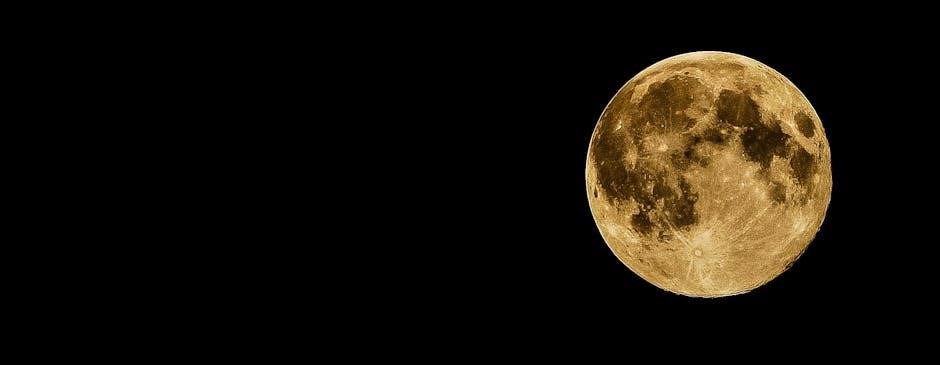
Activities and Worksheets
Engage students with interactive moon phase activities, such as modeling with Oreo cookies or creating a lunar cycle flip book. Worksheets like phase sequencing and observation journals enhance learning and retention.
Modeling the Phases of the Moon with Oreo Cookies
Modeling the phases of the moon using Oreo cookies is a fun and interactive activity that helps students visualize the lunar cycle. By twisting apart the cookies, learners can simulate how different portions of the moon’s illuminated side are visible from Earth. This hands-on approach makes complex concepts like the new moon, crescent, gibbous, and full moon phases more relatable and engaging. The activity aligns with educational standards, encouraging critical thinking and creativity while reinforcing scientific understanding. It also provides a tasty reward for students’ hard work, making it a memorable learning experience. This method is particularly effective for visual and tactile learners, ensuring a deeper comprehension of the moon’s phases.
To implement this activity, students will need a packet of Oreo cookies, a whiteboard for drawing, and a worksheet for documenting their observations. Teachers can guide the process by demonstrating each phase and explaining the corresponding astronomical phenomena. Safety precautions, such as checking for food allergies, should be taken beforehand. This activity not only enhances learning but also fosters collaboration and excitement about space science. It’s a simple yet powerful tool for teaching the lunar cycle in an engaging way. By connecting the activity to worksheets and diagrams, educators can ensure a comprehensive understanding of the moon’s phases and their significance.
Interactive Moon Phases Diagram Worksheet
An interactive moon phases diagram worksheet is a dynamic tool designed to enhance students’ understanding of the lunar cycle. This resource typically includes fillable fields, movable diagrams, and interactive elements that allow learners to engage with the material actively. By arranging the phases in sequence and labeling them, students can visualize how the moon’s appearance changes over time. The worksheet often features clear instructions and visual aids, making it accessible for young learners. It aligns with educational standards, promoting hands-on learning and critical thinking. This interactive approach not only reinforces scientific concepts but also fosters a deeper appreciation for astronomy. The worksheet is ideal for classroom use, providing a comprehensive and engaging way to explore the moon’s phases.
Many worksheets include additional features such as quizzes, diagrams, and fun facts to keep students interested. Teachers can use these tools to assess understanding and encourage further exploration of the lunar cycle. The interactive nature of the worksheet makes it a valuable resource for both in-class activities and homework assignments. By combining visual and textual elements, it caters to different learning styles, ensuring that all students can grasp the material effectively. This approach to learning the moon’s phases is both educational and enjoyable, making it a standout resource for astronomy education.
Moon Observation Activity
The Moon Observation Activity is a hands-on learning experience designed to help students track and understand the lunar cycle. By observing the moon over several nights, students can record its phases, noting changes in shape and brightness. This activity encourages students to connect theoretical knowledge with real-world observations, fostering a deeper appreciation for astronomy. Materials such as a moon journal, flashlight, and smartphone can be used to document findings. The activity promotes scientific inquiry and critical thinking, allowing students to explore the moon’s phases in a practical and engaging way. It is ideal for both classroom and homeschool settings, making learning fun and interactive.
Through regular observation, students develop an understanding of the moon’s orbit and its relationship with the Earth and Sun. This activity aligns with educational standards, providing a meaningful way to explore the lunar cycle. By participating in the Moon Observation Activity, students gain essential skills in observation, recording, and analysis, while also nurturing their curiosity about the night sky. This hands-on approach ensures that learning about the moon’s phases is both memorable and enjoyable for young learners.
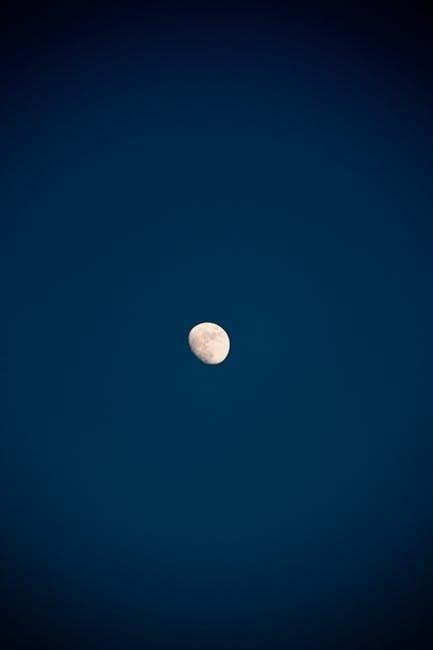
Educational Value

Engaging worksheets and activities enhance students’ understanding of the lunar cycle, promoting critical thinking and scientific literacy. These resources align with educational standards, fostering curiosity and hands-on learning experiences.
Teaching the Lunar Cycle in the Classroom
Teaching the lunar cycle in the classroom can be an engaging and interactive experience for students. Using worksheets and hands-on activities, educators can help students understand the phases of the moon and their sequence. Modeling activities, such as using Oreo cookies to represent the moon’s phases, provide a tactile learning experience. Interactive diagrams and step-by-step guides allow students to visualize and track the lunar cycle. These resources align with educational standards, promoting STEM skills and critical thinking. By incorporating both visual and practical elements, teachers can cater to diverse learning styles, ensuring students grasp the concept of the moon’s phases and their astronomical significance.

Aligning Worksheets with Educational Standards
Worksheets on the phases of the moon are designed to align with educational standards, ensuring they meet curriculum requirements. These resources often include clear objectives, such as understanding the lunar cycle and its causes. By incorporating fillable sections and interactive elements, worksheets promote active learning and assessment. They are structured to develop critical thinking and scientific literacy, making them suitable for various grade levels. Teachers can use these tools to monitor student progress and reinforce key concepts. With detailed instructions and visual aids, worksheets provide a comprehensive approach to teaching the moon’s phases, fostering both knowledge retention and practical application.
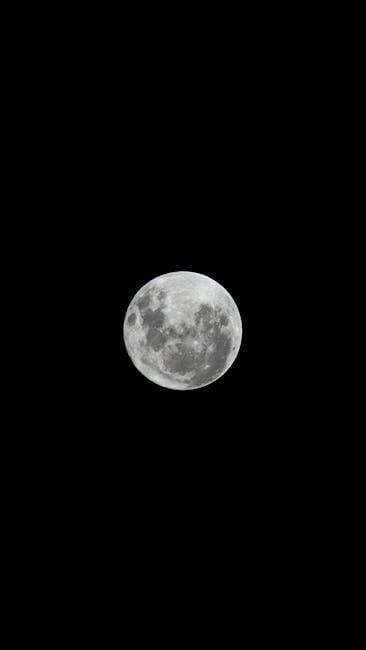
Cultural and Astronomical Significance
The phases of the moon hold deep cultural and astronomical importance, influencing calendars, traditions, and scientific understanding. They reflect orbital mechanics and Earth-Moon-Sun interactions, captivating humanity for centuries.
The Role of Moon Phases in Culture
Moon phases have deeply influenced human culture, shaping traditions, festivals, and myths. Many cultures celebrate the full moon with rituals, while the new moon often symbolizes renewal. Agricultural practices historically aligned with lunar cycles, as seen in harvest festivals. The waxing and waning phases inspired folklore, such as the Chinese Mid-Autumn Festival and Hindu Harvest Festival. These cultural ties reflect humanity’s enduring connection to the lunar cycle, highlighting its role in shaping identity and tradition across the globe.
Moon Phases and Astronomy
The study of moon phases is fundamental to astronomy, as it reveals the Moon’s orbital dynamics and its interaction with Earth and the Sun. The lunar cycle, lasting about 29.5 days, is driven by the Moon’s position relative to Earth and the Sun. Astronomers observe these phases to understand tidal forces, eclipses, and the Moon’s illumination patterns. The progression from new moon to full moon and back demonstrates the Moon’s constant motion. By analyzing these phases, scientists can predict celestial events and study the Earth-Moon-Sun system’s mechanics. This knowledge is essential for astronomy, providing insights into gravitational interactions and the behavior of our solar system. Educational resources, such as worksheets, help learners grasp these astronomical principles.
Understanding the phases of the moon enriches both astronomical knowledge and educational experiences. These resources, like worksheets, inspire curiosity and promote a deeper appreciation of celestial cycles.
The lunar cycle consists of eight distinct phases, each revealing a different portion of the Moon illuminated by the Sun. Starting with the New Moon, the cycle progresses through Waxing Crescent, First Quarter, Waxing Gibbous, Full Moon, Waning Gibbous, Last Quarter, and Waning Crescent. These phases occur as the Moon orbits Earth, changing its position relative to the Sun. Educational resources, such as worksheets and activities, help students visualize and understand this cycle. Interactive tools, like the Oreo cookie modeling activity, make learning engaging. Observing these phases fosters an appreciation for astronomy and the Moon’s role in shaping tides and cultural traditions. These concepts are essential for developing scientific literacy and curiosity about the universe.
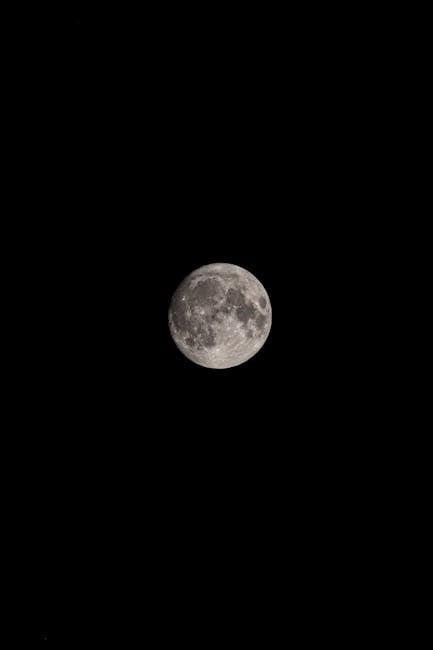
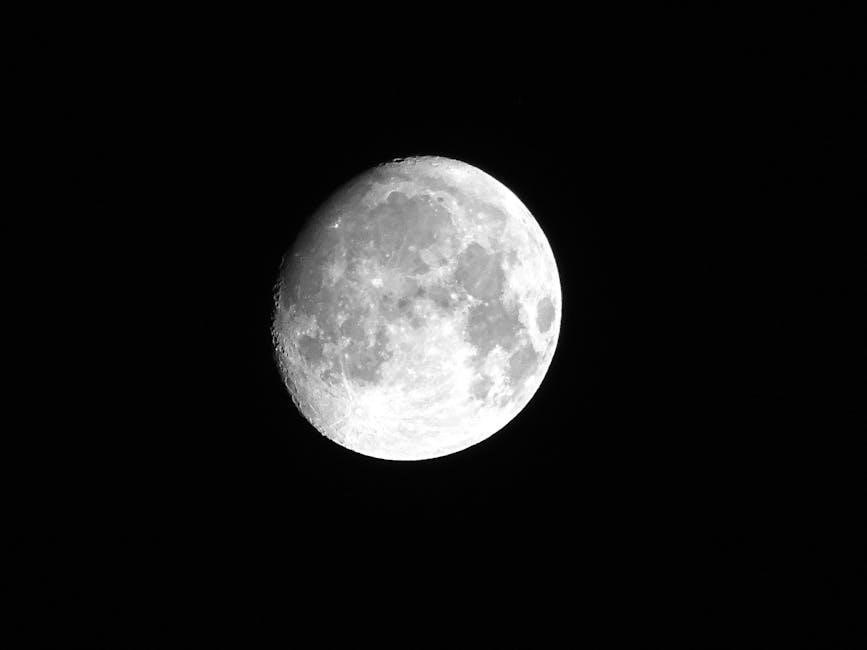
Encouraging Further Exploration
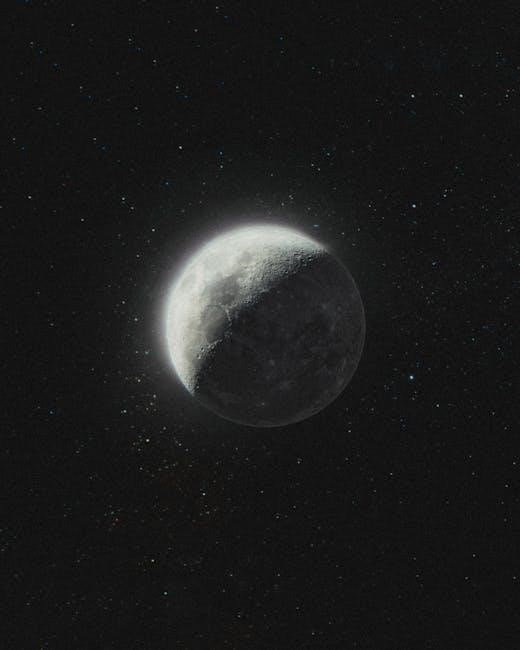
Exploring the phases of the Moon offers a gateway to deeper astronomical understanding. Encourage students to observe the Moon nightly, documenting its changes and connecting them to real-world phenomena like tides. Hands-on activities, such as creating a lunar cycle flipbook or using interactive diagrams, can spark curiosity. Discussing cultural and historical perspectives on the Moon adds richness to scientific learning. Providing resources like worksheets and online tools empowers students to continue their exploration independently. By fostering a sense of wonder and inquiry, educators can inspire students to delve further into astronomy and its relevance to our world.